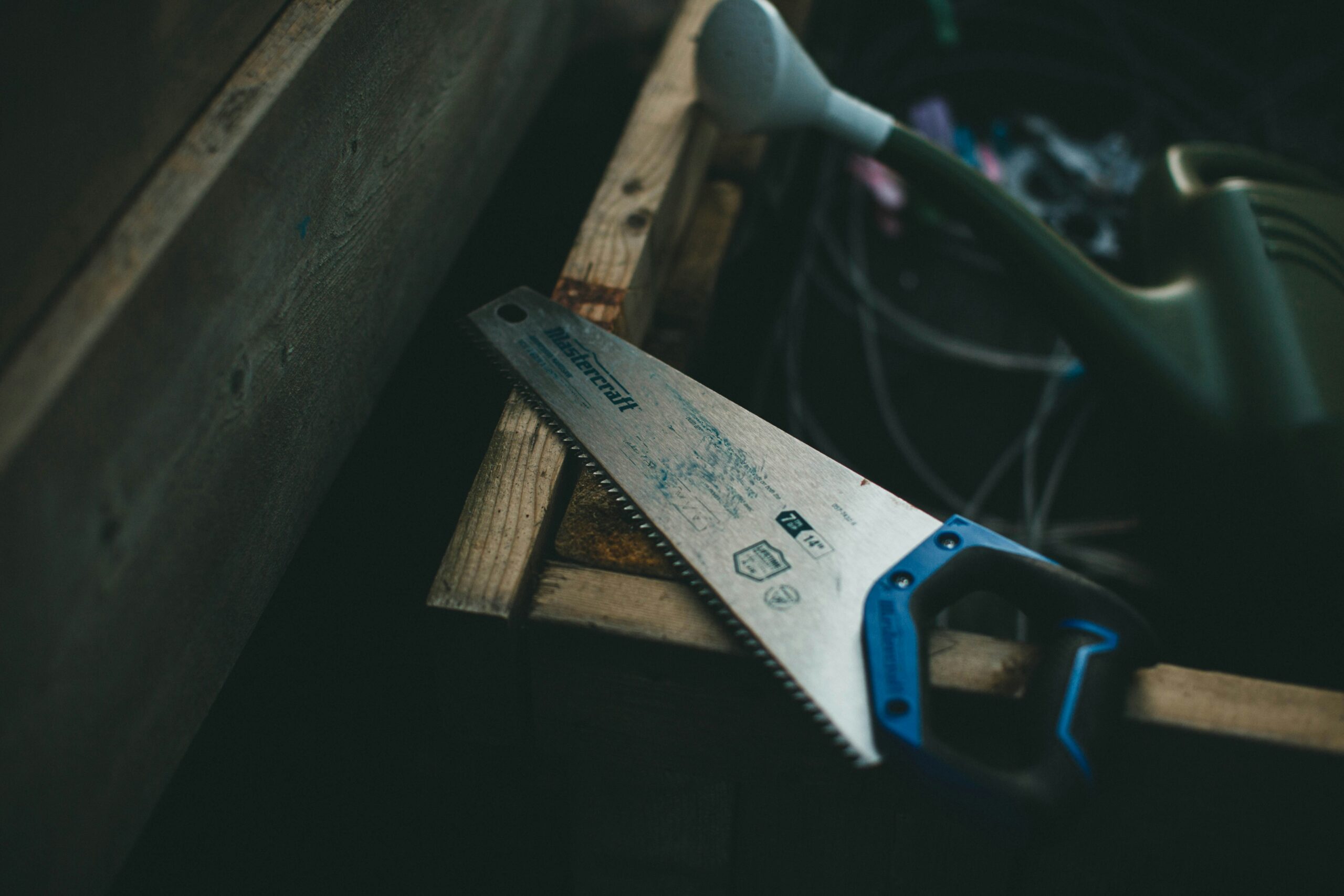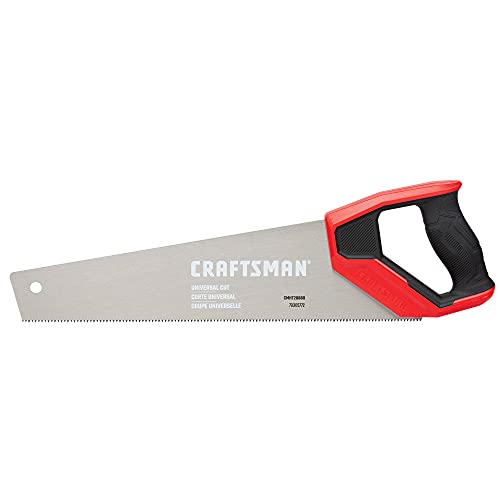Handsaws have been a fundamental tool in woodworking and various construction projects for centuries. Their simplicity, versatility, and effectiveness make them indispensable, even in an age dominated by power tools. This guide delves deep into the world of handsaws, providing detailed reviews of the best models available, insights into their types and uses, and a comprehensive FAQ section to address common questions and concerns.
Top Picks
- FAST & CLEAN CUTS: The hand saw has an exclusive tooth geometry for a fast clean cut
- DURABILITY: The handsaw features induction hardened teeth for a long lasting sharpness
- COMFORT: Ergonomically designed bi-material handle for comfort and control
- SQUARE & MITER: Handle offers a square & miter feature with 45-degree and 90-degree angles
- 3 SIDED RAZOR TEETH FOR EFFICIENT CUTTING: 10" blade is ideal for cutting 5" - 6" diameter, small to medium, branches
- ERGONOMICALLY DESIGNED, COMFORTABLE, CO-MOLDED HANDLE: Provides a comfortable grip for extended use
- EASY TO LATCH BLADE PREVENTS INJURY WHEN NOT IN USE: Folding blade is curved, taper-ground, and replaceable
- IMPULSE HARDENED TEETH FOR LONG SERVICE LIFE: Extends the life of the tool season after season
- UP TO 6 TEETH PER INCH AND CURVED BLADE DESIGN FOR FASTER CUTTING: Cuts are smoother and quicker than a traditional saw.
- Durable SK-5 steel blade for efficient cutting during camping survival bushcraft landscaping and general yard work
- Heavy duty rugged 11" long blade helps you power through thick branches faster, 11" blade is ideal for cutting 6" - 7" diameter branches
- Aggressive staggered teeth ( 7 TPI ) allows ultra smooth and sharp sawing
- Comfortable and longer rubber coated polymer handle ensures a firm grip in any weather condition
- Extra long design folding saw
Types of Handsaws
Handsaws come in numerous forms, each designed for specific tasks and materials. Understanding the different types of handsaws is crucial for selecting the right tool for your needs.
1. Rip Saws
Description: Rip saws are designed to cut along the grain of the wood. They have fewer, larger teeth compared to crosscut saws.
Key Features:
- Teeth: Large and few, typically 4-7 TPI (teeth per inch).
- Purpose: Ideal for ripping wood along the grain.
- Cut: Fast but rough.
Best For: Long, straight cuts along the grain in solid wood.
2. Crosscut Saws
Description: Crosscut saws are intended for cutting across the grain of the wood. They have more, smaller teeth than rip saws.
Key Features:
- Teeth: Smaller and more numerous, usually 8-15 TPI.
- Purpose: Cutting across the grain of the wood.
- Cut: Slower but cleaner than rip saws.
Best For: Precise cuts across the grain in solid wood and plywood.
3. Panel Saws
Description: Panel saws are similar to crosscut saws but shorter, making them more maneuverable.
Key Features:
- Length: Shorter blade, typically 20-24 inches.
- Purpose: General-purpose cutting, including both rip and crosscuts.
- Versatility: Suitable for small to medium-sized projects.
Best For: General woodworking, especially in confined spaces.
4. Back Saws
Description: Back saws have a stiffened spine that provides extra control and precision.
Key Features:
- Spine: Reinforced back for added rigidity.
- Teeth: Fine, typically 10-20 TPI.
- Purpose: Precision cutting.
Best For: Detailed woodworking, including dovetails and tenons.
5. Coping Saws
Description: Coping saws are used for intricate cuts, particularly in curves and detailed work.
Key Features:
- Blade: Thin, narrow blade.
- Frame: C-shaped frame to hold the blade.
- Teeth: Fine, often 15-20 TPI.
Best For: Cutting curves and intricate shapes in wood, plastic, and metal.
6. Bow Saws
Description: Bow saws are versatile tools with a frame that holds a long, narrow blade under tension.
Key Features:
- Frame: Bow-shaped frame to maintain blade tension.
- Blade: Long, narrow blade.
- Teeth: Can vary, typically 5-10 TPI.
Best For: Rough cutting of logs, branches, and large timbers.
Frequently Asked Questions (FAQ)
What is the difference between a rip saw and a crosscut saw? A rip saw is designed for cutting along the grain of the wood, with fewer, larger teeth for fast, rough cuts. A crosscut saw is intended for cutting across the grain, featuring more, smaller teeth for cleaner, more precise cuts.
How often should I sharpen my handsaw? The frequency of sharpening depends on usage. For regular use, sharpen your saw every few months. If you notice the saw is struggling to cut or the teeth are visibly worn, it’s time to sharpen.
Can I use a handsaw to cut metal? Certain handsaws, like hacksaws, are specifically designed for cutting metal. Regular wood-cutting handsaws are not suitable for metal and can become damaged if used on such materials.
What should I look for in a handsaw handle? Look for a handle that is ergonomically designed and made from comfortable, durable materials. A good handle reduces fatigue and provides better control during use.
Are there handsaws that can cut both wood and plastic? Yes, some handsaws, like the Irwin Tools Universal Handsaw, are designed with universal teeth that can cut through various materials, including wood and plastic.
How do I choose the right TPI for my project? Choose a lower TPI (4-7) for fast, rough cuts in thick materials. Opt for a higher TPI (10-20) for finer, more precise cuts in thinner materials or for detailed work.
What is the purpose of a back saw’s reinforced spine? The reinforced spine of a back saw adds rigidity and control, making it ideal for precise cutting tasks like joinery and fine woodworking.
Can I replace the blade on my handsaw? Some handsaws, particularly bow saws and hacksaws, have replaceable blades. Check the manufacturer’s specifications for compatibility and replacement procedures.
Is it worth investing in an expensive handsaw? Investing in a high-quality handsaw can be worthwhile if you frequently engage in woodworking or construction projects. Better materials and craftsmanship lead to more efficient, accurate, and durable tools.
How do I prevent my handsaw from rusting? To prevent rust, keep your handsaw clean and dry. Store it in a dry place and occasionally apply a light coat of oil to the blade. Wipe off any excess oil to avoid attracting dirt and debris.
How do I know if a handsaw blade is dull and needs sharpening? Signs of a dull blade include increased resistance while cutting, rough or jagged edges on the material, and a noticeable slowdown in cutting speed. If you find yourself exerting more effort to make cuts or if the saw produces uneven cuts, it’s time to sharpen the blade.
What safety precautions should I take when using a handsaw? Always wear safety goggles to protect your eyes from sawdust and debris. Use gloves to improve grip and protect your hands from splinters and cuts. Ensure the material you are cutting is securely clamped to avoid movement. Keep your fingers away from the cutting path, and make sure the saw blade is in good condition before use.
Can a handsaw be used for pruning trees and shrubs? Yes, certain types of handsaws, like pruning saws and bow saws, are specifically designed for cutting through tree branches and shrubs. These saws typically have coarse teeth to cut through green wood efficiently.
What is the ideal length for a handsaw blade for general woodworking? For general woodworking, a handsaw with a blade length between 20 to 26 inches is usually ideal. This length provides a good balance between maneuverability and cutting capacity, allowing for efficient cuts in various materials and sizes.
How do I properly tension the blade on a bow saw? To properly tension a bow saw blade, first, ensure the blade is securely attached to the saw frame. Tighten the tensioning mechanism (usually a wing nut or screw) until the blade is taut and produces a clear, sharp sound when plucked. Avoid overtightening, which can cause the blade to snap, and check the tension periodically during use to maintain optimal performance.
Best Handsaws
1. Bahco 10-30-23 30-Inch Ergo Bow Saw
Overview: The Bahco Ergo Bow Saw is a high-performance tool designed for demanding cutting tasks.
Key Features:
- Blade: 30 inches, hardened teeth.
- Frame: Ergonomic design with a comfortable grip.
- Purpose: Ideal for cutting green wood and dry wood.
Pros:
- Efficient and fast cutting.
- Ergonomically designed handle for comfort.
- Durable construction.
Cons:
- Larger size may be cumbersome for smaller tasks.
- Replacement blades can be expensive.
Best For: Heavy-duty cutting in forestry and landscaping.
2. Stanley 20-045 Fat Max Hand Saw
Overview: The Stanley Fat Max Hand Saw is known for its sharpness and durability.
Key Features:
- Blade: 15 inches, induction-hardened teeth.
- Handle: Ergonomically designed for comfort.
- Teeth: 9 TPI for aggressive cutting.
Pros:
- Sharp and aggressive teeth for fast cutting.
- Comfortable, non-slip handle.
- Durable and long-lasting blade.
Cons:
- Slightly heavier than some competitors.
- Not as precise for fine woodworking.
Best For: General-purpose woodworking and carpentry.
3. Shark Corp 10-2312 12-Inch Carpentry Saw
Overview: The Shark Corp Carpentry Saw is a versatile tool designed for precise cuts.
Key Features:
- Blade: 12 inches, flexible and thin.
- Teeth: Fine, triple-edged teeth.
- Purpose: Precision cutting in wood and plastic.
Pros:
- Extremely sharp and precise.
- Lightweight and easy to handle.
- Great for detailed work.
Cons:
- Limited to finer cuts.
- Blade can bend under heavy pressure.
Best For: Precision woodworking and finish carpentry.
4. DEWALT DWHT20547L 5-in-1 Hacksaw
Overview: The DEWALT 5-in-1 Hacksaw offers versatility with multiple configurations.
Key Features:
- Blade: Standard hacksaw blade, can be adjusted for different angles.
- Frame: Rugged and ergonomic design.
- Functionality: Converts into a jab saw and high-tension hacksaw.
Pros:
- Versatile and adaptable to different tasks.
- Sturdy and durable construction.
- Comfortable handle.
Cons:
- More expensive than single-purpose saws.
- Bulky compared to simpler designs.
Best For: Metalworking, plumbing, and general maintenance.
5. Irwin Tools 1773465 Universal Handsaw
Overview: The Irwin Universal Handsaw is designed for versatility and ease of use.
Key Features:
- Blade: 15 inches, universal teeth design.
- Teeth: 9 TPI for fast cuts in multiple materials.
- Handle: Ergonomic design with a comfortable grip.
Pros:
- Universal teeth for cutting a variety of materials.
- Fast and efficient cutting.
- Durable and reliable.
Cons:
- Not specialized for any single type of cut.
- Handle might be too large for small hands.
Best For: General-purpose cutting in wood, plastic, and drywall.
6. GreatNeck N2610 – 26 Inch 10 TPI Crosscut Saw
Overview: The GreatNeck N2610 is a traditional crosscut saw designed for reliability and performance.
Key Features:
- Blade: 26 inches, carbon steel.
- Teeth: 10 TPI for precise crosscutting.
- Handle: Hardwood with a comfortable grip.
Pros:
- Traditional design and feel.
- Sharp and durable teeth.
- Good balance and weight.
Cons:
- Limited to crosscutting tasks.
- Requires regular maintenance to keep sharp.
Best For: Traditional woodworking and fine crosscutting tasks.
Choosing the Right Handsaw
Selecting the best handsaw depends on various factors, including the type of material you’re working with, the nature of the cut, and your personal preferences. Here are some considerations to help you make the right choice:
1. Purpose and Application
Identify the primary use for the handsaw. Different tasks require different types of saws. For instance, a coping saw is excellent for intricate cuts, while a rip saw is best for cutting along the grain of wood.
2. Tooth Count and Configuration
Teeth per inch (TPI) is a crucial factor in determining the saw’s performance. Lower TPI means faster, rougher cuts, suitable for rip saws. Higher TPI provides finer, slower cuts, ideal for back saws and crosscut saws.
3. Blade Material and Quality
High-quality steel blades are essential for durability and sharpness. Look for saws with hardened or induction-hardened teeth for longer-lasting sharpness.
4. Handle Design and Comfort
An ergonomic handle can reduce fatigue and improve control. Handles made from materials like rubber or soft plastic offer better grip and comfort.
5. Size and Portability
Consider the size of the saw relative to your workspace and storage. Larger saws provide longer cuts but can be cumbersome, while smaller saws are easier to handle and store.
6. Versatility and Adjustability
Some handsaws offer multiple configurations or adjustable blades, adding to their versatility. These features can be beneficial for varied tasks.
Handsaw Maintenance Tips
Proper maintenance is essential to keep your handsaw in good condition and ensure optimal performance. Here are some maintenance tips:
1. Regular Cleaning
After each use, clean the saw blade to remove resin, sap, and debris. Use a cloth with a mild solvent or soapy water, ensuring the blade is dry before storage to prevent rust.
2. Sharpening the Teeth
Over time, the teeth of the saw may become dull. Use a saw file to sharpen the teeth periodically. Follow the original angle of the teeth for consistent cutting performance.
3. Lubrication
Occasionally lubricate the blade with a light oil to reduce friction and prevent rust. Wipe off excess oil to avoid attracting dirt and debris.
4. Proper Storage
Store the saw in a dry place, preferably in a toolbox or a sheath. Avoid exposure to moisture and extreme temperatures, as they can damage the blade and handle.
5. Handle Care
Check the handle for cracks or splinters. Sand down rough areas and apply a wood conditioner or oil to wooden handles to maintain their integrity.
6. Blade Tension
For bow and coping saws, ensure the blade tension is correct. A loose blade can lead to inaccurate cuts, while an overly tight blade can snap under pressure.
Conclusion
Handsaws remain essential tools in woodworking and construction, offering precision and control that power tools often can’t match. Understanding the different types of handsaws and their specific uses helps in selecting the right tool for your tasks. This guide has reviewed some of the best handsaws available, highlighting their key features, pros, and cons, and provided tips for maintenance and choosing the right saw.
Whether you are a professional woodworker or a DIY enthusiast, investing in a quality handsaw can significantly enhance your work’s efficiency and quality. By considering your specific needs and preferences, you can find a handsaw that will serve you well for years to come.






